Avram Hershko
Biographical
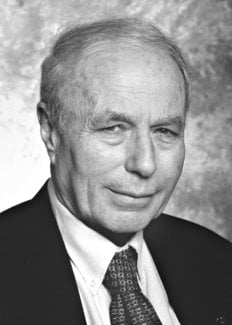
I was born on December 31, 1937, in Karcag, Hungary. Karcag is a small town of around 25,000 inhabitants, about 150 kilometers east of Budapest. It had a Jewish community of nearly one thousand people. My father, Moshe Hershko, was a schoolteacher in the Jewish elementary school in Karcag; most of the Jewish children in that town were his students. His former students from Hungary, and later from Israel, described him with admiration as an inspiring teacher and a role model educator. My mother Shoshana/Margit (“Manci”) was an educated and musically gifted woman. She gave some English and piano lessons to children in Karcag. My older brother, Chaim, was born in 1936, less than two years before me. My mother wanted very much to have also a baby girl, but the times were at the eve of World War II, Hitler’s screams could be frequently heard on the radio, my parents became apprehensive of the future and thus did not try to have more children. Still, my recollections of my early childhood are of very happy times, with loving and supporting parents, growing up in a nice house with a beautiful garden, created by my father who was also an amateur (but avid) gardener. A family picture from these times, with my parents, my brother and I as an infant, shows well the warmth of my family.
This early paradise was lost rapidly and brutally. World War II broke out, and soon Hungary joined in as an ally of Nazi Germany. In 1942, my father was taken by the Hungarian Army to serve as a forced laborer, in the company of other Jewish men. They were sent to the Russian front, where most of them perished. Luckily for my father, the Soviet Army advanced so rapidly after Stalingrad that he was captured by the Soviets before the Nazis could kill him. Then, he was used by the Soviets as a forced laborer. He was released only in 1946, so we did not know for four years whether or not he was alive.
In the spring of 1944, Hungary’s dictator Horthy understood that Germany was loosing the war, and planned to desert. The Germans sensed this and quickly occupied Hungary. This was followed by the rapid extermination of much of the Jewish population of Hungary. In May-June 1944, most Jewish people were concentrated in ghettos and then transported to death camps in Poland. I was six years old at that time. We were in a ghetto at the outskirts of Karcag for a couple of weeks and then were transferred to a terribly crowded ghetto in Szolnok, which is a larger city in the same district. From there, Jews from the entire district were transported further on freight-trains. They were told that they were sent to work, but after the war we learned that most of the trains were headed for Auschwitz. By some random event, my family and I were put on one of the few trains that headed for Austria, where Jews were actually used for labor. This group included my mother with us two children, my paternal grandparents and my three aunts. In Austria we were in a small village near Vienna, where adults worked in the fields and in a factory. We were liberated by the Soviet Army on the spring of 1945. My maternal grandparents perished in the Holocaust, along with 360,000 Hungarian Jews and almost two-thirds of the Jewish people of Karcag. Following our reunion with my father in 1946, the family lived for three years in Budapest, where my father found job as a schoolteacher. The family emigrated to Israel in 1950.
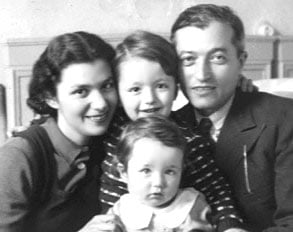
In Israel we settled in Jerusalem and I started a new and very different life. Of course, there were initial difficulties of being new immigrants. We had to learn a new language, Hebrew. This was not too difficult for children (I was less than 13 at that time), but it was more difficult for my parents. Still, my father studied Hebrew and soon started to work, again as a schoolteacher. (Later he taught in at a teachers’ seminary and authored mathematics textbooks, which were very popular in Israel). As always, education of their children was my parents’ highest priority. Although we were quite poor immigrants at that time, my brother and I were sent to an expensive private school in Jerusalem. I suspect that most of the salary of my father was spent on our tuition fees.
At school I was received well by the other children. These were times of massive immigration to Israel, so a new immigrant child with a Hungarian accent did not stand out too much (I am told that I still have some Hungarian accent, especially in English, though my Hungarian language is quite poor now). I was a good student, and learned easily different subjects, such as mathematics, physics, literature, history and even Talmud! That became a problem when I finished high school. I was interested in too many subjects, so it was difficult for me to decide how to continue. I chose to study medicine, probably by default, because my brother Chaim was already a medical student, so I could inherit his books for free! Chaim always wanted to be a physician, and he is now a very well-known hematologist and an authority on iron metabolism.
In 1956, I started to study at the Hebrew University – Hadassah Medical School in Jerusalem, which was the only medical school in Israel at that time (there are now four). In the basic science part of my medical studies, I fell in love with biochemistry. I studied biochemistry in three different courses: organic chemistry, basic biochemistry and a course called “physiological chemistry”, which was medically oriented biochemistry. I was very fortunate to have outstanding teachers in all three courses. Organic chemistry was taught by Yeshayahu Leibowitz, a legendary person in Israel, a highly original thinker whose knowledge encompassed philosophy, political science, the Bible, Talmud, medicine, chemistry and more. He was probably my best teacher, it was an intellectual feast to listen to him. Leibowitz loved biochemistry, and he sneaked biochemistry into his lectures on organic chemistry whenever he could, which was often. Basic biochemistry was taught by Shlomo Hestrin, also an inspiring teacher who had a special talent of transferring his enthusiasm for science to the students. Physiological chemistry was taught by Ernst Wertheimer, a professor of German Jewish origin whom we had some difficulty to understand because of his heavy German accent, but who had an excellent perspective of integration of metabolism at the level of the total body and of physiological contexts of biochemistry. Another part of the same course was taught by Jacob Mager. Mager was an outstanding biochemist and a man of encyclopedic knowledge. However, he was very shy and quite a bad classroom teacher (though an excellent teacher in the laboratory, as I learned later). Most of his lectures were delivered while he was writing whole metabolic pathways on the blackboard, without any notes, with his face to the blackboard and his back directed to the class. Still, I was so much impressed by the depth and breadth of his knowledge of biochemistry that I decided to ask Mager to do some research in his laboratory.
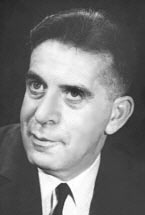
I started to work in Mager’s laboratory in 1960. At that time, there was no formal M.D.-Ph.D. program at the Hebrew University, but it was possible to do a year of research between the preclinical and the clinical years of medical studies. I did that, and although I completed medical studies later on, I already knew by the end of that year that I was going to do research, rather than clinical practice. I was very fortunate to have had Jacob Mager as my mentor and tutor of biochemical research. He was a scientist with incredible scope of interests and knowledge. He was interested in every subject in biomedicine, he knew almost everything about every subject and he worked simultaneously on 3-4 completely different research projects. This undoubtedly caused fragmentation of his contributions to science, but provided his students with a broad experience in different areas of biochemistry in a single, relatively small laboratory. In a period of a few years I worked with Mager on subjects as different as the effects of polyamines on protein synthesis in vitro, glucose-6-hosphate dehydrogenase deficiency and a variety of aspects of purine nucleotide metabolism, including enzymology and regulation. During this time, I also finished my medical studies, did my military service as a physician (1965-1967) and then returned for two more years to Mager’s laboratory to finish my Ph.D. thesis (1967-69). I received not just a broad view of biochemistry from Mager, but also a very solid base. He was a very rigorous experimentalist, every experiment had to be done with all possible positive and negative controls, all experiments were carried out in the duplicate, and every significant new finding had to be repeated several times to make it sufficiently credible. I owe a lot to Jacob Mager for a strong background of rigorous biochemistry.
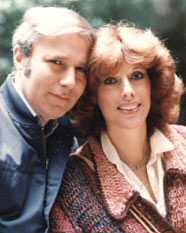
I met Judith (née Leibowitz) in 1963, and we married at the end of the same year. Judy was born and raised in Switzerland. After her studies in biology, she decided to spend a year in Israel. During this year, she worked in the hematology laboratory of the Hadassah hospital in Jerusalem. One day, I walked over to the hematology laboratory to get a blood sample that I needed for my research, and we literarily bumped into each other. This collision caused her to stay in Israel for more than one year, and now we are married for over 41 years. We have three sons: Dan (1964), Yair (1968) and Oded (1975). Dan is a surgeon, Yair is a computer engineer and Oded is a medical student. We have now six grandchildren: Maya (1994), Lee (1997), Roni (1998), Ela (2000), Ori (2002) and Shahar (2004). Needless to say, both Judy and I are crazy about all our grandchildren. During all our years together, I got tremendous support from Judy. Although she came from one of the world’s most peaceful countries to one of the least, and from a very comfortable and pampering environment to quite primitive surroundings, she stood her ground with a lot of energy, courage and cheerful optimism. She always took care of all my possible needs, as well as the needs of our children and grandchildren. Judy is not only a very beautiful woman, but she also radiates a lot of caring, love and compassion. In addition to providing so much support at home, she also helped me a lot in the laboratory over a period of more than 15 years. The ubiquitin system was helped by Judy in more than one way.
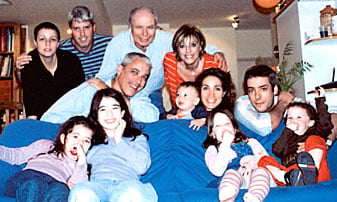
In 1969-71 I was a post-doctoral fellow with Gordon Tomkins at the Department of Biochemistry and Biophysics of the University of California in San Francisco. I met Gordon the previous year, when he gave some lectures in Israel. He was very different from Mager: outgoing, vivacious, bursting with original ideas. Unlike Mager, Gordon did not care much about controls or experimental detail, but he was a volcano of a man, constantly erupting with great ideas and he was a wonderful stimulator of many other researchers’ work as well. Many distinguished scientists who knew Gordon Tomkins at that time (unfortunately, he died at an early age) are still speaking of him with great admiration. He exuded a great personal charm and I liked him instantly. I thought that Gordon may add some new dimensions to my development in science and this indeed was the case. I got a lot of stimulation and biological perspective from Gordon, while I continued to use what I learned from Mager about rigorous controls. As described in the accompanying lecture, I learned about protein degradation and got fascinated with this process while I was working with Gordon Tomkins.
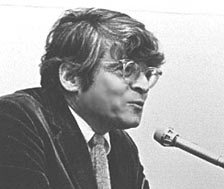
I returned from San Francisco to Israel in 1971. Originally, I planned to return to the Hebrew University in Jerusalem, but a new medical school opened in Haifa and I was offered to be its Chairman of Biochemistry. This sounded very challenging and I agreed, but later it turned out to be a very minute Unit of Biochemistry in a very small Faculty of Medicine of the Technion, so at the beginning I chaired mainly myself. One initial reason for its being so small was that there was not enough space to house much faculty. The whole Faculty of Medicine was housed, on a temporary basis, in an old two-floor monastery. This “temporary” situation lasted for more than 15 years, until the new building of the Faculty of Medicine was completed in 1987. However, I had great times in that old monastery, and much of the discovery of the ubiquitin system was done right there. Isolation may at times lead to creativity, since one is not bothered by what others are doing and does not feel compelled to work on currently popular, “fashionable” subjects. I was very fortunate to assemble there a highly devoted research team, that included at the beginning Hanna Heller and Dvora Ganoth, and later, at different times, Ety Eytan, my wife Judy, Sarah Elias and Clara Segal. Dvora and Ety still work with me. My first graduate students were David Epstein, Yaacov Hod and Michael Aviram. For a number of years, we tried to establish a cell-free system that reproduces energy-dependent protein degradation in the test tube, essential for the biochemical analysis of this system. For this purpose, we tried different sources, such as liver homogenates and extracts from cultured cells and even from bacteria. We did not have any success in all these attempts. I remember that a biochemist friend from Jerusalem visited my laboratory and at the end of the visit she told me that I should not have most of my laboratory working on a hopeless subject. However, I was very obstinate and was obsessed with the idea that it would be possible to find out how proteins are degraded only with a biochemically analyzable cell-free system. Maybe I was lucky to work in such a remote and small place; in a larger institution, my graduate students and research assistants may have deserted me for some less frustrating research. Finally we used for biochemical fractionation the reticulocyte cell-free system established in the Goldberg laboratory (see Lecture). At that time, Aaron Ciechanover joined my laboratory for a D. Sc. thesis, after completing his medical studies and army service. Aaron was the most incredibly hard-working graduate student that I ever had. With his huge energies, he contributed a lot to the discovery of the ubiquitin system. He was also a natural manager, even as a graduate student. I recall that at the end of my sabbatical year in Philadelphia in 1978 (see below), after telling Ernie Rose how small the Israeli research grants were, Ernie suggested that I should apply for a foreign research grant from the NIH to support my work in Israel. I was inclined to do a couple of more experiments instead of writing a grant application, but Aaron pushed me into a chair and commanded: “now write the NIH grant application!” I wrote it and got the grant, the first of five consecutive grant periods supported by the NIH. It saved the situation in the Haifa lab at a very critical time. I am very grateful to the NIH for supporting my work and also to Aaron for forcing me to write the initial grant application.
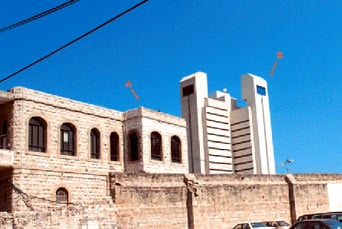
The story of the discovery of the ubiquitin system is described in my lecture, and here I add only some anecdotal episodes from these times. The fractionation of reticulocyte lysates to Fractions 1 and 2 was based on a trick that I learned from Mager in the purification of enzymes of purine nucleotide metabolism from erythrocytes. Hemoglobin constitutes about 80-90% of total protein of erythrocytes and reticulocytes, and therefore the first task in the purification of any enzyme from these cells is to get rid of the great mass of hemoglobin. This is most conveniently done by using the anion exchange resin DEAE-cellulose, which binds most non-hemoglobin proteins, but not hemoglobin. In our case, this procedure resulted in loss of activity, which could be recovered by adding back Fraction 1 that contained not only hemoglobin but also ubiquitin. In fact, in our laboratory jargon we called ubiquitin for some time “Red”, because of the red color of hemoglobin in this fraction. After we found that the factor in this fraction (i.e., ubiquitin) remains active after boiling for 30 minutes, we consulted a protein expert at the Technion who told us that our factor cannot be a protein. We found, however, that it is a protein, based on its sensitivity to the action of proteinases. Maybe the lesson from this story is that it is dangerous to consult experts.
After working for 6 years at the Technion, I had a sabbatical year due in 1977-78. I had a problem in choosing a person with whom I would spend my sabbatical year. I knew the people in the (then) small protein degradation field, and I was not very enthusiastic. Many people in the field had their pet theories about the cause for the high selectivity of intracellular protein degradation, without much (or any) experimental evidence. Once again, I was lucky. In 1976, I attended a Fogarty meeting on a quite general subject at the National Institutes of Health. Irwin Rose also attended this meeting, and one morning I joined him at the breakfast table. Ernie was well known for his work on enzyme mechanisms. In the course of our conversation, I asked Ernie in what else was he interested, and his reply was: “protein degradation”. I was a bit taken aback and told him that I never saw anything published by him on protein degradation. His reply was: “There is nothing worth publishing on protein degradation!” I liked his critical attitude and Ernie being such a character and therefore I asked him to spend my sabbatical year in his laboratory. It turned out that Ernie Rose was really interested in protein degradation. When he had been a young faculty in the fifties at the Department of Biochemistry of Yale University, he talked to Melvin Simpson, another young faculty there, and Simpson told him about his experiments on the energy-dependence of the liberation of amino acids from proteins in liver slices (see Lecture). This aroused Ernie’s interest, and from time to time he did experiments trying to understand the energy-dependence of protein degradation. He did not make any significant progress in these experiments, therefore he did not publish anything on protein degradation.
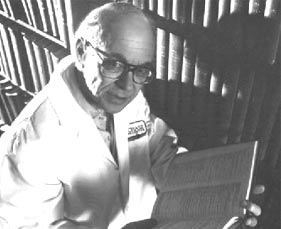
Ernie Rose is the third person, in addition to Mager and Tomkins, who had a great influence on my scientific life. He is very different from both Mager and from Tomkins. He likes problem solving, and his attitude to science is highly analytical. I am more intuitive, so we complemented each other very well. He is so brilliant that people do not always understand his ideas and are a little afraid of him. People are also often apprehensive of him because he can be very critical, and does not hesitate to voice his criticisms. We got along very well over a period of 20 years, which included several sabbaticals and many summer visits in his laboratory at Fox Chase Cancer Center in Philadelphia. Our only disputes were when he refused to be co-author of work to which he actually made significant contributions. In the case of the few papers on which he is co-author, I had to force him to agree. He was most unselfish in our joint work, a rare phenomenon in today’s science. I asked him once why he keeps inviting me back to his laboratory, and his answer was: “I like the excitement.” Ernie always downplayed his contributions to the ubiquitin field. He wrote an autobiographical article for Protein Science in 1995, and the word “ubiquitin” is not mentioned in this recollections paper. In our conversations he always described his role in the ubiquitin story as being merely supportive, but this is certainly not true. Although on occasions, when I worked in his laboratory and he was adsorbed with some problem in enzyme mechanisms, he would forget about my existence for a week or two, but then suddenly he would come up with a bright suggestion about my current work. I can state that Ernie’s input of ideas, inspiration and helpful criticism were essential for the discovery of the ubiquitin system and for the delineation of some of the main enzymatic reactions in this pathway.
The rest of my story is a lot about more work, but also a lot of more scientific excitement and fun. I continued to be obstinate, and continued to do what many considered to be old-fashioned biochemistry in the eighties, when the powerful technologies of molecular biology became available. This biochemical work resulted in the discovery of the three types of enzymes involved in ubiquitin-protein ligation (E1, E2 and E3), and of some further enzymes of this system. Subsequently, I became interested in the roles of ubiquitin-mediated protein degradation in the cell division cycle. This led me to the Marine Biological Laboratory (MBL) at Woods Hole, due to the availability of a clam oocycte cell-free system, which faithfully reproduces cell cycle related events in the test tube. This system was important for the discovery of the Cyclosome/Anaphase-Promoting Complex, as described in the Lecture. In the past decade, I spend my summers at the MBL for the same reason that I spent my summers previously at Fox Chase Cancer Center – to be able to devote almost all my time to do experiments in a tranquil environment. Benchwork is my great hobby; I also do benchwork in Haifa, but on a more part-time basis. I have always loved to do experiments with my own hands, both for peace of mind and for excitement. Also, my own experiments were important for almost every significant progress made in my laboratory. One cannot have a more beautiful place than the MBL for doing experiments: the great natural beauty of the surroundings, the tranquility and outstanding scientific environment – all combine to make the MBL a great place for doing summer research.
When I look back at my life until now, I am amazed how fortunate I have been in both my personal and my scientific life. After escaping the Holocaust, both my parents lived in Israel to a good old age. I am very happy with my wife, children and grandchildren. I was very fortunate to have outstanding mentors in science, and then to be able to use the knowledge gained for a significant contribution. If only there were some peace in the world, including between Israel and its neighbors – I would be completely satisfied.
This autobiography/biography was written at the time of the award and later published in the book series Les Prix Nobel/ Nobel Lectures/The Nobel Prizes. The information is sometimes updated with an addendum submitted by the Laureate.
Nobel Prizes and laureates
Six prizes were awarded for achievements that have conferred the greatest benefit to humankind. The 12 laureates' work and discoveries range from proteins' structures and machine learning to fighting for a world free of nuclear weapons.
See them all presented here.
